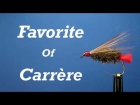Small and large flies for sea trout
I highly recommend using small flies for fall fishing for sea trout and rainbows in salt water. The fish have been feeding all summer and can be picky and veeery slow and reluctant to take any fly offered to them.
I highly recommend using small flies for fall fishing for sea trout and rainbows in salt water. The fish have been feeding all summer and can be picky and veeery slow and reluctant to take any fly offered to them.

One more fell for the Moyerfokker. This 1½-2 kilo fish took with vigor in bright daylight and gin clear water.
Boring flies
When brought home and examined the fish will mostly reveal a stomach filled with the smallest and most discrete animals in the ocean popularly known as sea flees. These are less then 5 millimeters (1/5 of an inch) in length and are a dull shade of grey in color. Some species are red or slightly pink, but mostly they are just... boring.
Hence the imitations are also very boring. The most boring one is a pattern that doesn't hardly deserve a name, but to my knowledge is generally known as the Killer Bug.
I usually start out with this fly at tying demos because everybody can learn to tie it. It's also so easy that I can't fail... Last - but not least - tying this fly also demonstrates how little it takes to tie a good fishing fly. It's nothing but grey dubbing on a hook. Thats it! It's one of my most productive flies for rainbow in salt water and a very good autumn fly in clear, calm water. And it's a good imitation.
A Bully and a classic
The Copper Bully is a pattern I started using with great succes this spring. It was shown to me by a guy in a local flyshop, and proved its worth on its first few trips. I tie it smaller than the original and use some copper dubbing which is not as bright as that used on the original. My version could rightfully be called a Fancy Killer Bug.
My last small, fall favorite is a true classic. The Red Tag is a regular in my fly box. I use two versions: an ordinary wet fly tied on a streamer hook and a low water version tied on a hook almost the same size. The idea of low water flies is old as Methusalem (almost) and is simply a way of tying a small fly on a larger hook. My thought was that when it can be done with salmon flies, it can also be done with Danish salt water flies. A small fly on a big and sturdy hook - ready to take on a 5 kilo (10 lbs) fish.
Size does matter
Small flies are mostly the right stuff for fall fishing... mostly. Some times the small flies just don't work. Don't ask me why. The fish are supposed to eat small things, and mostly they only have very small things inside them. My flies imitate those small things and should be perfect for 'matching the hatch'. But the fish just don't seem to bite.
If the cure for fish not taking large flies is decreasing fly size then the cure for fish not taking small flies must be the opposite. Using this simple logic I have started changing to larger flies when small ones are refused.
My two favorites for this stunt are the Black Frede - a variation of an old and trusty friend, The Grey Frede - and a new fly, The Moyerfokker. The latter was inspired by Morten Valeur's large Pike Streamer, slightly shrinked and modified. The fly is still large by my normal standards, but thanks the the mylar flash which does not soak water it's light and easy to cast. The eyes make the soft mylar work very well in the water.
Low Water Red Tag
Materials
| Hook |
Gamakatsu F-16, size 4 or 8. Any down eye 2X streamer hook can be used. Stainless or salt water resistant recommended. |
| Thread | Black |
| Tail | Red wool |
| Rib | Copper wire |
| Body | Three strands of peacock herl |
| Hackle | Small, soft, brown hen hackle |
| Head | Thread |
Tying Instructions
- Start the thread behind the hook eye
- Cut off a short length of red wool
- Tie in one eye width behind hook eye
- Cover wool with tying thread to the middle of hook shank
- Cut wool leaving a small tuft for tail
- Tie in copper wire under hook shank
- Wind thread to front of wool
- Tie in three strands of peacock herl
- Cover herl with tying thread to the middle of hook shank
- Twist herl and thread a to form a peacock rope
- Wind herl to form a tight, cylindrical body
- Prepare a small, soft hen hackle
- Tie in base first in front of body
- Wind the hackle 3-4 times backwards to form a mini palmer hackle
- Wind ribbing 3-4 times forwards over hackle to secure it
- Tie down copper and cut surplus
- Form a small head from the tying thread
- Whip finish
- Varnish
Copper Bully (Kobberbassen)
Materials
| Hook |
Short shank wet fly hook size 8-10 |
| Thread | Red or orange |
| Rib | Copper wire (optional) |
| Body | Copper flash dubbing Angel Hair, SLF or equal |
| Head | Thread |
Tying Instructions
- Start the thread behind the hook eye
- Cover hook shank with thread
- Tie in optional ribbing
- Dub with flash dubbing to a slightly tapered shape
- Rib counterclockwise, tie down and cut ribbing
- Form a small head from the tying thread
- Whip finish
- Varnish
- Tease out material with velcro
Killer Bug
materials
| Hook |
Small wet fly hook, size 10 or 12 |
| Thread | Black |
| Rib | Copper wire (optional) |
| Body | Natural grey hare's or rabbit dubbing |
| Head | Thread |
Tying Instructions
- Start the thread behind the hook eye
- Cover hook shank with thread
- Tie in optional ribbing
- Dub with wool to a slightly tapered shape
- Rib counterclockwise, tie down and cut ribbing
- Form a small head from the tying thread
- Whip finish
- Varnish
Moyerfokker
Materials
| Hook |
Gamakatsu F-16, Tiemco TMC 700 or similar heavy, Limerick bend hook size 2-4 |
| Thread | Black |
| Tail | Black and silver flash |
| Body | None |
| Hackle | Black and silver flash |
| Eyes | Bead chain |
| Head | Thread |
Tying Instructions
- Start the thread over the hook bend
- All flash straws should end up a bit longer than the hook
- Tie in a bunch of black flash over the hook shank
- Tie in a bunch of silver flash under the hook shank
- Whip finish, don't cut thread, but varnish over the bases of flash
- Let dry before continuing
- Advance thread to an eye width behind hook eye
- Tie in one more bunch of black flash over the hook shank
- Tie in one more bunch of silver flash under the hook shank
- Tie in bead chain eyes under the hook shank
- Whip finish
- Varnish
Black Frede
Materials
| Hook |
Kamasan B840 size 2 |
| Head | Medium brass bead |
| Thread | Black |
| Tail | Black marabou feathers and a few flash straws |
| Rib | Copper wire |
| Body | Black marabou dubbing |
| Hackle | Large, black hen hackle |
Tying Instructions
- Slip the bead over the hook bend and secure behind hook eye with glue or varnish
- Start the thread behind the bead
- Cover the hook shank with thread
- Tie in flash over the hook bend
- Tie in two marabou feathers - one on each side of the hook shank
- Leave the base of the feathers and tie them down over the hook shank to right behind the bead
- Fold the feathers back and tie down to form a base for the body
- Cover the feathers with tying thread finishing over the hook bend
- Cut surplus
- Tie in copper wire under hook shank
- Dub the thread heavily with marabou dubbing. Use wax if necessary
- Form a thick, fluffy body
- Prepare a large, soft hen hackle
- Tie in base first, shiny side facing forwards in front of body, just behind bead
- Wind the hackle 4-6 times backwards to form a palmer hackle
- Wind ribbing 4-6 times forwards over hackle to secure it
- Tie down copper and cut surplus
- Whip finish just behind bead
- Varnish
Read more about why you should register.
More content from the front page
Since you got this far …
… I have a small favor to ask.
Long story short
Support the Global FlyFisher through several different channels, including PayPal.
Long story longer
The Global FlyFisher has been online since the mid-90's and has been free to access for everybody since day one – and will stay free for as long as I run it.
But that doesn't mean that it's free to run.
It costs money to drive a large site like this.
See more details about what you can do to help in this blog post.































































Comments
Martin The Moyer
Martin
The Moyerfokker works like a champ on tidewater bass , awesome pattern
thank you
michael